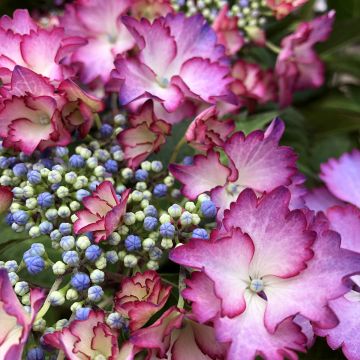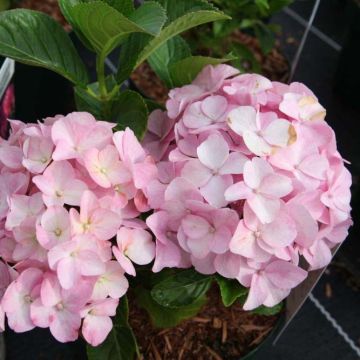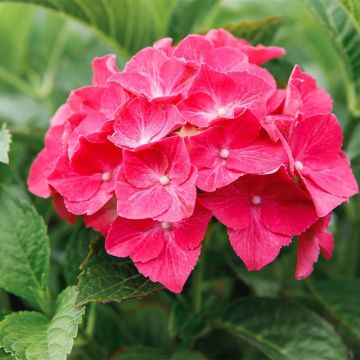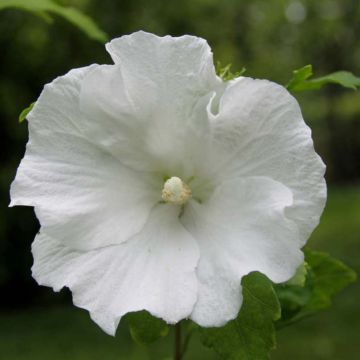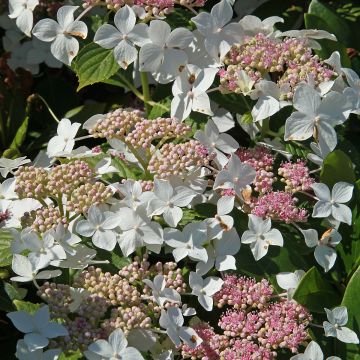

Hydrangea macrophylla So Long Rosy


Hydrangea macrophylla So Long Rosy


Hydrangea macrophylla So Long Rosy
Hydrangea macrophylla So Long Rosy
Hydrangea macrophylla x serrata So Long® Rosy 'Coumont'
Due to its hardiness, my choice for this spring is to plant in large wooden containers on my terrace.
Michèle, 22/10/2020
Special offer!
Receive a €20 voucher for any order over €90 (excluding delivery costs, credit notes, and plastic-free options)!
1- Add your favorite plants to your cart.
2- Once you have reached €90, confirm your order (you can even choose the delivery date!).
3- As soon as your order is shipped, you will receive an email containing your voucher code, valid for 3 months (90 days).
Your voucher is unique and can only be used once, for any order with a minimum value of €20, excluding delivery costs.
Can be combined with other current offers, non-divisible and non-refundable.
Home or relay delivery (depending on size and destination)
Schedule delivery date,
and select date in basket
This plant carries a 24 months recovery warranty
More information
We guarantee the quality of our plants for a full growing cycle, and will replace at our expense any plant that fails to recover under normal climatic and planting conditions.
Would this plant suit my garden?
Set up your Plantfit profile →
Description
The 'So Long Rosy' is a new hybrid hydrangea series that combines the best qualities of its parent plants. This plant can resist cold weather and bloom on the current year's wood. It has beautiful inflorescences that shift from soft pink to chartreuse green. It blooms early and continually throughout the summer despite rain with well-coloured flowers. Its semi-spherical flower heads gradually evolve from pale pink to chartreuse green. The plant is not too big, compact, and well-branched, making it easy to fit in a small garden or container on the terrace. It grows best in semi-shade.
Hydrangea serrata are plants that thrive in cool and humid mountainous regions and are resistant to cold temperatures as low as -20°C (-4°F). They are less affected by late frosts compared to their large-leaved counterparts, all of which belong to the Hydrangeaceae family. The 'So Long Rosy' hortensia is a very bushy plant that can grow up to 1.10 m (3 ft 7 in) in height and 80 cm (31.5 in) in width, depending on the cultivation conditions. It starts to flower at a young age, and its hemispherical panicles, about 13 cm (5.1 in) wide, bloom from June. If the plant is pruned slightly after the first flowering, it will form new flowers during summer. This hydrangea has large, medium-green, ovate leaves with a dentate border, which fall in autumn. It's worth noting that hydrangeas are sturdy plants that can survive for at least 50 years.
Hydrangea So Long Rosy is the perfect plant for adding a romantic touch to your garden. This plant thrives in fresh soils and semi-shaded areas, making it perfect for placing near the house, on the terrace, or near the entrance. You can also place it on the east or west side, as long as it is not in direct sunlight. Even if they are not fond of limestone, hydrangeas are not strictly ericaceous plants, they like humus-rich, fertile and fresh soils. Pair them with other plants such as fuchsias magellanica, annual impatiens, lilies, Pieris, Sarcococca, or plant spring-flowering bulbs in front of their round shape. You can admire their beautiful and long-lasting flowers in your garden or even indoors. Their dried flowers look great in bouquets, so don't be too quick to put them on the compost heap after they have bloomed.
Report an error about the product description
Hydrangea macrophylla So Long Rosy in pictures






Plant habit
Flowering
Foliage
Botanical data
Hydrangea
macrophylla x serrata
So Long® Rosy 'Coumont'
Hydrangeaceae
Cultivar or hybrid
Other Hydrangea Macrophylla
View all →Planting and care
To plant the So Long Rosy hydrangea, choose a slightly shaded spot in spring or early autumn, such as against an east-facing or northern wall. Keep it away from cold winds and the sun. It prefers deep, fresh, well-drained, and relatively fertile soil, but ericaceous soil is unnecessary. You can enrich the soil with a good base fertiliser before planting. If the soil is dry at the foot of the wall, plant the root ball at least 30-40 cm (11.8-15.7 in) away from the base and add well-rotted compost to improve soil freshness. This plant is resilient and can be planted in cold areas. When pruning, remove the faded flowers on the first or second bud. To encourage the formation of young shoots, cut back a quarter or a third of the oldest stems to the base when the plant matures. Prune every year in March or April.
Planting period
Intended location
Care
-
, onOrder confirmed
Reply from on Promesse de fleurs
Similar products
Haven't found what you were looking for?
Hardiness is the lowest winter temperature a plant can endure without suffering serious damage or even dying. However, hardiness is affected by location (a sheltered area, such as a patio), protection (winter cover) and soil type (hardiness is improved by well-drained soil).

Photo Sharing Terms & Conditions
In order to encourage gardeners to interact and share their experiences, Promesse de fleurs offers various media enabling content to be uploaded onto its Site - in particular via the ‘Photo sharing’ module.
The User agrees to refrain from:
- Posting any content that is illegal, prejudicial, insulting, racist, inciteful to hatred, revisionist, contrary to public decency, that infringes on privacy or on the privacy rights of third parties, in particular the publicity rights of persons and goods, intellectual property rights, or the right to privacy.
- Submitting content on behalf of a third party;
- Impersonate the identity of a third party and/or publish any personal information about a third party;
In general, the User undertakes to refrain from any unethical behaviour.
All Content (in particular text, comments, files, images, photos, videos, creative works, etc.), which may be subject to property or intellectual property rights, image or other private rights, shall remain the property of the User, subject to the limited rights granted by the terms of the licence granted by Promesse de fleurs as stated below. Users are at liberty to publish or not to publish such Content on the Site, notably via the ‘Photo Sharing’ facility, and accept that this Content shall be made public and freely accessible, notably on the Internet.
Users further acknowledge, undertake to have ,and guarantee that they hold all necessary rights and permissions to publish such material on the Site, in particular with regard to the legislation in force pertaining to any privacy, property, intellectual property, image, or contractual rights, or rights of any other nature. By publishing such Content on the Site, Users acknowledge accepting full liability as publishers of the Content within the meaning of the law, and grant Promesse de fleurs, free of charge, an inclusive, worldwide licence for the said Content for the entire duration of its publication, including all reproduction, representation, up/downloading, displaying, performing, transmission, and storage rights.
Users also grant permission for their name to be linked to the Content and accept that this link may not always be made available.
By engaging in posting material, Users consent to their Content becoming automatically accessible on the Internet, in particular on other sites and/or blogs and/or web pages of the Promesse de fleurs site, including in particular social pages and the Promesse de fleurs catalogue.
Users may secure the removal of entrusted content free of charge by issuing a simple request via our contact form.
The flowering period indicated on our website applies to countries and regions located in USDA zone 8 (France, the United Kingdom, Ireland, the Netherlands, etc.)
It will vary according to where you live:
- In zones 9 to 10 (Italy, Spain, Greece, etc.), flowering will occur about 2 to 4 weeks earlier.
- In zones 6 to 7 (Germany, Poland, Slovenia, and lower mountainous regions), flowering will be delayed by 2 to 3 weeks.
- In zone 5 (Central Europe, Scandinavia), blooming will be delayed by 3 to 5 weeks.
In temperate climates, pruning of spring-flowering shrubs (forsythia, spireas, etc.) should be done just after flowering.
Pruning of summer-flowering shrubs (Indian Lilac, Perovskia, etc.) can be done in winter or spring.
In cold regions as well as with frost-sensitive plants, avoid pruning too early when severe frosts may still occur.
The planting period indicated on our website applies to countries and regions located in USDA zone 8 (France, United Kingdom, Ireland, Netherlands).
It will vary according to where you live:
- In Mediterranean zones (Marseille, Madrid, Milan, etc.), autumn and winter are the best planting periods.
- In continental zones (Strasbourg, Munich, Vienna, etc.), delay planting by 2 to 3 weeks in spring and bring it forward by 2 to 4 weeks in autumn.
- In mountainous regions (the Alps, Pyrenees, Carpathians, etc.), it is best to plant in late spring (May-June) or late summer (August-September).
The harvesting period indicated on our website applies to countries and regions in USDA zone 8 (France, England, Ireland, the Netherlands).
In colder areas (Scandinavia, Poland, Austria...) fruit and vegetable harvests are likely to be delayed by 3-4 weeks.
In warmer areas (Italy, Spain, Greece, etc.), harvesting will probably take place earlier, depending on weather conditions.
The sowing periods indicated on our website apply to countries and regions within USDA Zone 8 (France, UK, Ireland, Netherlands).
In colder areas (Scandinavia, Poland, Austria...), delay any outdoor sowing by 3-4 weeks, or sow under glass.
In warmer climes (Italy, Spain, Greece, etc.), bring outdoor sowing forward by a few weeks.

































